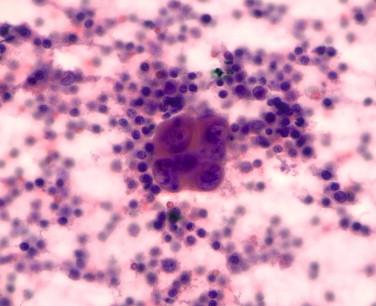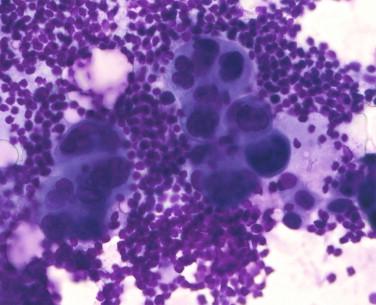Physical Address
304 North Cardinal St.
Dorchester Center, MA 02124
Cytologic imprints, scrape preparations, and smears (collectively called cytopreps ) have been used for intraoperative diagnosis for over 80 years (Dudgeon and Patrick, 1927). In the current era of subspecialty ascendancy, the demonstrated value of cytopreps (Sakai and Lauslahti, 1969; Kontozoglou and Cramer, 1991; Sidawy and Silverberg, 1991) as an extension of surgical pathology may be underappreciated by noncytopathologists. Rapid fixation of cells without introduction of frozen section (FS) artifact may provide information about nuclear and cytoplasmic features which may be lost or distorted during FS processing that complement the architectural information provided by the latter. Such features make the cytoprep an extremely useful tool which has comparable accuracy to routine FS, and which, when used in conjunction with FS, can improve the overall accuracy of intraoperative consultation over either method alone (Mair et al, 1991).
Cytopreps have additional distinct advantages in the intraoperative consultation suite ( Tables 2-1 and 2-2 ). Of increasing importance is the preservation of lesional tissue for diagnostic purposes, as well as for triage of tissue for biorepository storage or ancillary studies such as cytogenetics, flow cytometry, or chemosensitivity studies. This is of particular importance when the sample is quite limited, such as in computed tomography (CT) or endoscopic ultrasound guided core-needle biopsies. In larger specimens, cytopreps allow for easier and more rapid sampling of multiple macroscopically heterogeneous areas; this is also of value in some smaller specimens requiring aggressive sampling, such as grossly negative sentinel nodes. When infectious disease is suspected, use of cytopreps may avoid cryostat contamination use in suspected granulomatous disease of lung or lymph node. Lastly, and significantly in a busy intraoperative consultation service, cytoprep slides can be prepared much more quickly than conventional frozen section slides (though interpretation is not necessarily faster).
|
| Advantages of intraoperative cytology |
|
| Disadvantages of intraoperative cytology |
|
First and foremost, the technique is operator dependent. Increasingly, cytology is treated as a separate (and limited) aspect of residency training, and many anatomic pathologists have discomfort in relying on cytologic interpretation. As a practical matter, comfort can be rapidly developed by preparing imprint or smear slides for side-by-side comparison of frozen sections, particularly when the former are rapid fixed and stained with hematoxylin and eosin as well. Cytology preparations generally lack architectural information or provide insight into the relationship of the lesion with surrounding structures, and there is disagreement about their value (or lack thereof) for margin assessment (Sidawy and Silverberg, 1991; Klimberg et al, 1998; Florell et al, 2001; Bui et al, 2008). Lastly, some lesions, particularly those with desmoplastic or sclerotic stroma, may exfoliate very few cells. A negative study in a paucicellular specimen should therefore be regarded with great caution, with a low threshold maintained for performing a frozen section.
The first and foremost step in obtaining good cytology preparations is careful gross examination of the tissue at hand and selection of appropriate areas for sampling. In general, solid areas of a visible lesion are preferred, avoiding necrotic areas or cystic fluid. If cut surfaces are variegated, multiple cytopreps sampling various areas may increase diagnostic yield. For specimens such as sentinel nodes, in which gross examination may show no macroscopic lesion, it is important to section the specimen at regular and close intervals to prepare a “tissue pool” comprising scraped material from all cut surfaces to adequately sample the specimen.
Common methods of cell transfer include scraping, imprinting, and spreading (Nochomovitz et al, 1989; DeLellis et al, 2006). The choice of method may vary, depending on specimen type or personal preference. As a rule, firm tumors yield few cells on imprint or spreading but may yield more with scrape techniques. Scrape technique is likely to be more successful in yielding metastatic tumor from lymph nodes but may cause more crush effect; evaluation of suspected lymphoma is often better handled by touch imprints.
For scraping , the lesional cut surface should be scraped several times in the same direction with a clean, dry scalpel blade on the advancing edge of which a semiliquid cell suspension will accumulate. Excessive scraping should be avoided because excess suspension will not adhere to the blade and thick smears may show poor preservation in any event. The angle blade should be drawn along the length of the slide depositing a single streak of suspended cells; moving the blade back and forth across the slide may cause excessive cell damage. Alternatively, the cell suspension may be placed as a drop on the slide and drawn across with a slide or coverslip. A third alternative is to deposit the suspension in the middle of a microslide and appose a second slide to disperse the suspension and separate the two slides in a sliding motion; although this method can damage cells, when properly performed it is useful for making preparations in which one slide may be rapid fixed and the other set aside for air-dried, Romanowsky-stained preparations ( Table 2-3 ).
| Scrape |
|
| Imprint |
|
Imprinting the freshly cut surface against the clear-glass, dry slide may be done by touching the tissue gently. This method is best for soft and highly cellular tissues and tends to better preserve cytoplasm. Air-dry effect can happen quickly with this technique, and for stains requiring rapid fixation it is best performed over or very close to the fixative jar with immediate suspension following the imprint preparation.
The spreading method deposits loose cells by spreading the tissue surface across the glass slide but can produce many crushed cells if too much pressure is applied.
It is probably easiest for most surgical pathologists to correlate morphologic findings from standard frozen sections with intraoperative cytopreps that have been prepared using rapid-fixed slides, stained with hematoxylin and eosin (H&E). Rapid-fixed preparations, whether stained by H&E or rapid Papanicolaou, generally show preservation of nuclear features comparable or superior to those seen in standard tissue sections; tinctorial qualities of both nuclei and cytoplasm will be more familiar with H&E ( Figure 2-1 ). Nevertheless, air-dried smears with Romanowsky stain (most commonly Diff-Quik) have some advantages. In rapidly screening lymph nodes for metastasis, the air-dried preparations accentuate differences in nuclear size and improve ready identification of multiple cell populations ( Figure 2-2 ). Cytoplasmic details are often better preserved, and extracellular matrix (colloid, mucus, chondroid, osteoid) is often both better retained by the air-dry step and stains metachromatically for more ready identification. For lymphoma specimen triage, Diff-Quick staining of air-dried imprints may be preferred by hematopathologists, who are often more adept at interpretation of Romanowsky-stained slides.


Become a Clinical Tree membership for Full access and enjoy Unlimited articles
If you are a member. Log in here